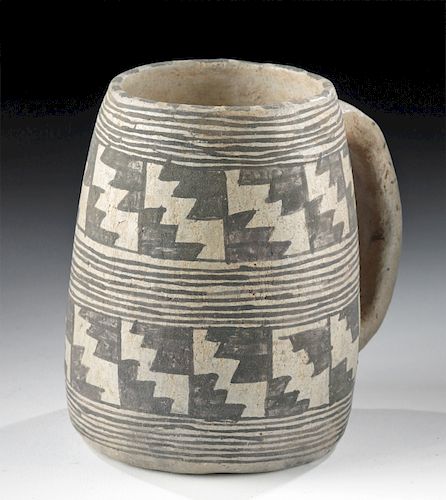Prehistoric Anasazi Black-on-White Mug, ex-Museum
Lot 57
About Seller
Artemis Fine Arts
686 S Taylor Ave, Ste 106
Louisville, CO 80027
United States
Selling antiquities, ancient and ethnographic art online since 1993, Artemis Gallery specializes in Classical Antiquities (Egyptian, Greek, Roman, Near Eastern), Asian, Pre-Columbian, African / Tribal / Oceanographic art. Our extensive inventory includes pottery, stone, metal, wood, glass and textil...Read more
Estimate:
$1,500 - $2,000
Absentee vs Live bid
Two ways to bid:
- Leave a max absentee bid and the platform will bid on your behalf up to your maximum bid during the live auction.
- Bid live during the auction and your bids will be submitted real-time to the auctioneer.
Bid Increments
| Price | Bid Increment |
|---|---|
| $0 | $25 |
| $300 | $50 |
| $1,000 | $100 |
| $2,000 | $250 |
| $5,000 | $500 |
| $10,000 | $1,000 |
| $20,000 | $2,500 |
| $50,000 | $5,000 |
| $100,000 | $10,000 |
| $200,000 | $20,000 |
About Auction
By Artemis Fine Arts
Oct 3, 2019
Set Reminder
2019-10-03 10:00:00
2019-10-03 10:00:00
America/New_York
Bidsquare
Bidsquare : Exceptional Day 2: Pre-Columbian & Tribal Art
https://www.bidsquare.com/auctions/artemis-gallery/exceptional-day-2-pre-columbian-tribal-art-4453
Day 2 of an important 2-day auction featuring exceptional, museum-worthy examples of Pre-Columbian from the ancient Americas, Native American, African / Tribal, Oceanic, Spanish Colonial and fossils. Artemis Fine Arts info@artemisgallery.com
Day 2 of an important 2-day auction featuring exceptional, museum-worthy examples of Pre-Columbian from the ancient Americas, Native American, African / Tribal, Oceanic, Spanish Colonial and fossils. Artemis Fine Arts info@artemisgallery.com
- Lot Description
Native American, Southwestern USA, Colorado, Anasazi/Ancestral Puebloans, ca. 1200 to 1300 CE. A fine example of a pottery mug made in the Mesa Verde Black-on-White tradition in what is today southwestern Colorado. The body of the mug is a tapering cylinder, with a circular neck and a wide strap handle extending from below the rim to the base. On the handle and body is a complex design of interlocking triangular and stepped patterns, perhaps meant to evoke the shape of cliff dwellings, with two bands of these "steps" surrounded by tight horizontal lines that wrap around the body and form thick borders. Size: 4.5" W x 4.75" H (11.4 cm x 12.1 cm)
Vessels from this tradition were made from a gray or white clay with angular fragments of temper and this one has a pearly gray-white slip that was then overpainted with a black pigment made from carbon. Largely, these were made by women who lived in cliff dwellings like those seen at Mesa Verde National Park - indeed at the Park, there is a large house containing 94 rooms, a kiva, and a water reservoir, known as Mug House because its European discoverers, Charles Mason and the Wetherill brothers, found three mugs hung in one of the rooms from a rope of woven yucca.
Provenance: ex-Joan Shaw collection, bought in 1971; loaned to the Mesa Verde Museum, 1962-1970; ex-Bill Mitchell collection, Cortez, Colorado, USA, from 1958-1962
All items legal to buy/sell under U.S. Statute covering cultural patrimony Code 2600, CHAPTER 14, and are guaranteed to be as described or your money back.
A Certificate of Authenticity will accompany all winning bids.
We ship worldwide and handle all shipping in-house for your convenience.
#147985Intact and in a beautiful state of preservation, with the pigment still sharp and clear over the entire body. Nice deposits, mainly on interior. Old collection number on underside.Condition
- Shipping Info
-
All shipping is handled in-house for your convenience. Your invoice from Artemis Gallery will include shipping calculation instructions. If in doubt, please inquire BEFORE bidding for estimated shipping costs for individual items.
-
- Buyer's Premium



 EUR
EUR CAD
CAD AUD
AUD GBP
GBP MXN
MXN HKD
HKD CNY
CNY MYR
MYR SEK
SEK SGD
SGD CHF
CHF THB
THB
















